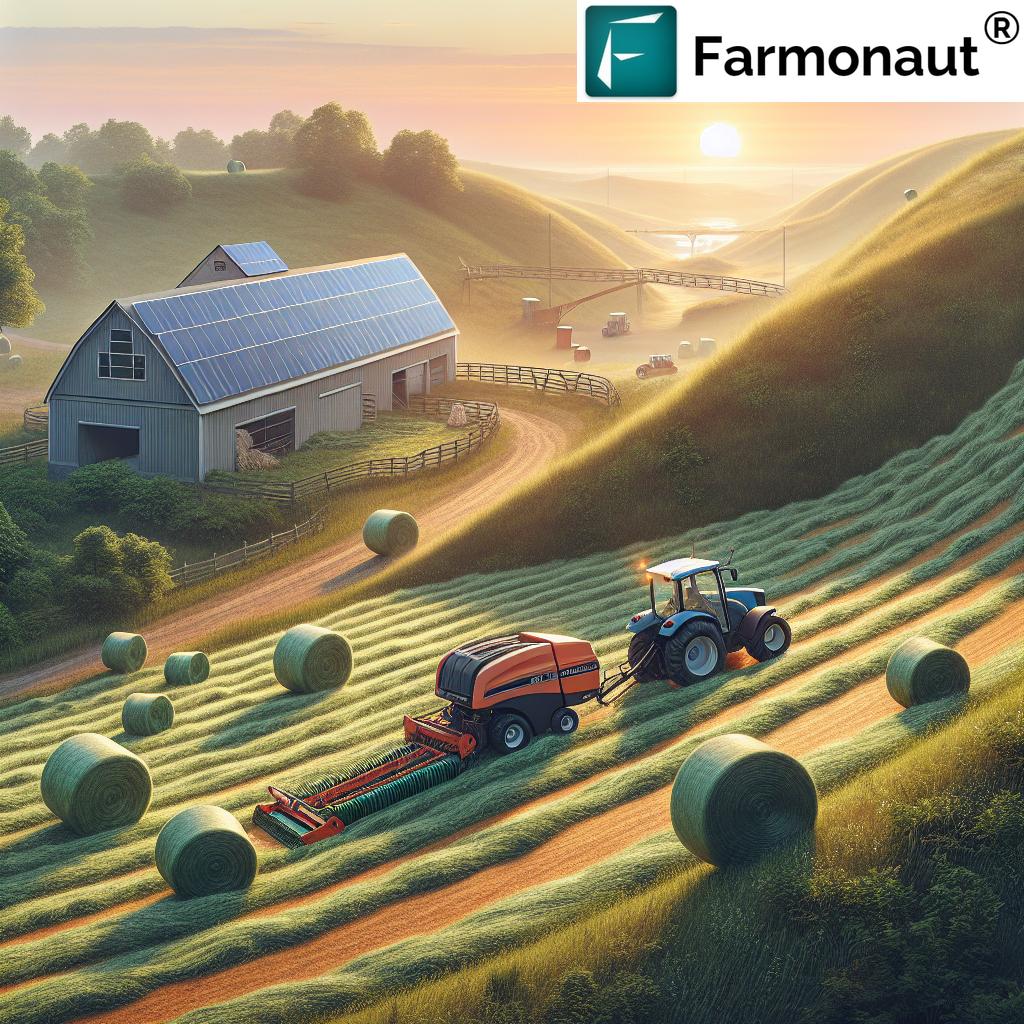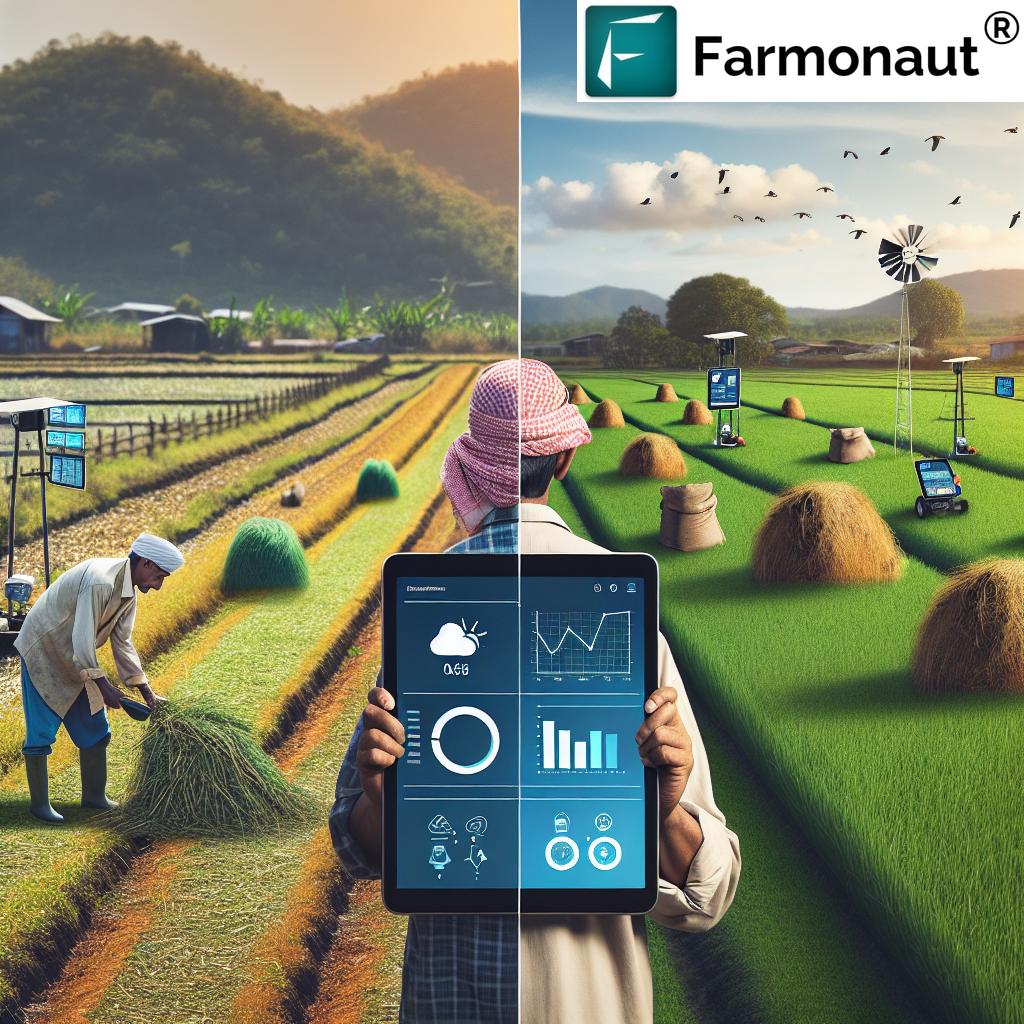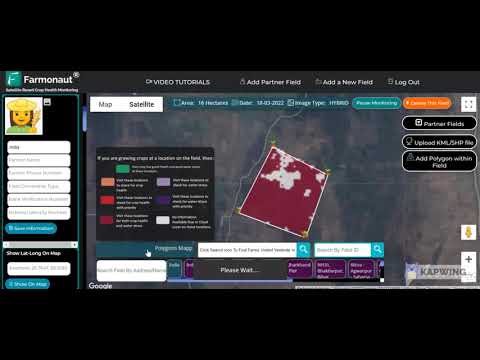Mastering Small-Scale Hay Farming: Efficient Techniques for Ontario’s Rough Terrain and Rising Prices
“Small-scale hay farming is resurging, with producers adapting to rising prices and declining production across 20% of Ontario’s rough terrain.”
Welcome to our comprehensive guide on small-scale hay farming in Ontario! As we navigate the challenges of rising prices and rough terrain, we’re excited to share innovative techniques that are transforming the industry. At Farmonaut, we’re committed to empowering farmers with cutting-edge technology and data-driven insights to optimize their operations.

The Resurgence of Small-Scale Hay Farming
In recent years, we’ve witnessed a significant shift in the agricultural landscape of Ontario. Small-scale hay farming is experiencing a remarkable resurgence, driven by a combination of factors:
- Rising hay prices
- Declining production in traditional areas
- Increasing demand for locally-sourced, high-quality forage
- Growing interest in sustainable farming practices
This trend has opened up new opportunities for farmers with small acreages to enter the hay market and make a substantial impact. Let’s delve into the efficient techniques that are making this possible, even in Ontario’s challenging terrain.
Precision Agriculture: A Game-Changer for Small Farms
One of the most significant advancements in small-scale hay farming is the adoption of precision agriculture techniques. These methods allow farmers to optimize their operations, even on limited acreage and rough terrain.
Satellite-Based Crop Monitoring
At Farmonaut, we’re proud to offer cutting-edge satellite-based crop monitoring services that are revolutionizing hay farming. Our technology provides real-time insights into:
- Vegetation health (NDVI)
- Soil moisture levels
- Weather patterns
By leveraging this data, small-scale farmers can make informed decisions about irrigation, fertilization, and harvesting times, ultimately improving hay quality and yield.
Access our powerful satellite monitoring tools:
Adapting to Ontario’s Rough Terrain
Ontario’s diverse landscape presents unique challenges for hay farmers, particularly those working on a small scale. However, with the right approach and equipment, these obstacles can be overcome.
Specialized Farm Machinery for Rough Terrain
Investing in the right equipment is crucial for success in small-scale hay farming on challenging land. Some key pieces of machinery to consider include:
- Compact Tractors: Ideal for navigating tight spaces and uneven ground
- Multi-Purpose Implements: Versatile tools that can perform multiple tasks, saving space and money
- Small Balers: Designed for lower yields and easier maneuverability
- All-Terrain Vehicles (ATVs): Useful for quick inspections and light hauling tasks
These specialized tools enable small-scale farmers to work efficiently in areas that might be challenging for larger equipment.
Terracing and Contour Farming
For farms with particularly steep or uneven terrain, terracing and contour farming techniques can be invaluable. These methods help to:
- Reduce soil erosion
- Improve water retention
- Create level areas for easier machinery operation
By implementing these practices, small-scale hay farmers in Ontario can maximize their land use and boost productivity, even on challenging sites.
Optimizing Hay Nutritional Content
“Custom harvesters can increase hay nutritional content by up to 15% through precision agriculture techniques in small acreage farming.”
Producing high-quality hay is essential for small-scale farmers to remain competitive in the market. Here are some strategies to optimize the nutritional content of your hay:
Timing is Everything: Perfect Your Cutting Schedule
The timing of hay cutting significantly impacts its nutritional value. We recommend:
- Cutting grass hay just before or at early bloom stage
- Harvesting legumes like alfalfa at late bud to early bloom
- Monitoring plant maturity closely using our satellite imaging technology
By optimizing your cutting schedule, you can maximize the protein content and digestibility of your hay.
Soil Testing and Targeted Fertilization
Regular soil testing is crucial for maintaining optimal growing conditions. Our precision agriculture tools can help you:
- Identify nutrient deficiencies
- Create targeted fertilization plans
- Monitor soil health over time
By addressing specific soil needs, you can improve both the yield and quality of your hay crop.
Cost-Effective Hay Cultivation Strategies
As small-scale farmers, it’s crucial to maximize efficiency and minimize costs. Here are some strategies to help you achieve cost-effective hay cultivation:
Implement Rotational Grazing
Rotational grazing can significantly reduce the need for mechanical harvesting while improving pasture health. Benefits include:
- Reduced equipment and fuel costs
- Improved soil fertility through natural fertilization
- Extended grazing season
By integrating livestock into your hay production system, you can create a more sustainable and cost-effective operation.
Utilize Cover Crops
Incorporating cover crops into your rotation can provide multiple benefits:
- Improved soil health and structure
- Increased organic matter content
- Natural weed suppression
- Additional forage source in some cases
These practices can help reduce input costs while improving the overall health of your hay fields.

Leveraging Technology for Small-Scale Success
At Farmonaut, we believe that technology can level the playing field for small-scale hay farmers. Our suite of tools is designed to provide valuable insights and improve decision-making processes.
Jeevn AI Advisory System
Our AI-driven farm advisory tool, Jeevn AI, offers personalized recommendations based on your specific farm conditions. It provides:
- Real-time weather forecasts
- Crop management strategies
- Pest and disease alerts
By leveraging this technology, small-scale hay farmers can make informed decisions that optimize their operations.
Blockchain-Based Traceability
For farmers looking to differentiate their products in the market, our blockchain-based traceability solution offers:
- Transparent supply chain tracking
- Verification of production methods
- Enhanced consumer trust
This technology can be particularly valuable for small-scale farmers producing high-quality, specialty hay products.
Explore our API for custom integrations:
Navigating Agricultural Economics Trends
Understanding current agricultural economics trends is crucial for small-scale hay farmers to make informed decisions and remain competitive. Let’s explore some key trends affecting the industry:
Rising Input Costs
The cost of farm inputs, including fertilizers, fuel, and equipment, has been steadily increasing. To mitigate these rising costs, consider:
- Implementing precision agriculture techniques to optimize input use
- Exploring alternative fertilization methods, such as composting or manure management
- Investing in energy-efficient equipment
Shifting Market Demands
Consumer preferences and market demands are evolving. Stay ahead of the curve by:
- Producing high-quality, nutrient-dense hay
- Exploring niche markets, such as organic or specialty hay for specific livestock
- Building direct relationships with local buyers
Climate Change Impacts
Climate change is affecting growing conditions and increasing the frequency of extreme weather events. Adapt your operation by:
- Implementing drought-resistant varieties and irrigation strategies
- Utilizing our weather forecasting tools to plan harvesting and field operations
- Diversifying your crop rotation to spread risk
Comparative Analysis of Small-Scale Hay Farming Techniques
To help you make informed decisions about your farming methods, we’ve compiled a comparative analysis of various small-scale hay farming techniques suitable for Ontario’s challenging conditions:
| Farming Method | Equipment Used | Yield Potential (tons/acre) | Cost Efficiency ($/ton) | Nutritional Content (protein %) | Drought Resistance | Suitability for Rough Terrain |
|---|---|---|---|---|---|---|
| Traditional Manual Harvesting | Hand tools, small tractors | 1.5 – 2.5 | 120 – 150 | 8 – 12% | Low | High |
| Modern Precision Agriculture | GPS-guided equipment, drones | 3.0 – 4.5 | 90 – 110 | 12 – 16% | Medium | Medium |
| Custom Harvesting Services | Specialized machinery (rented) | 2.5 – 3.5 | 100 – 130 | 10 – 14% | Medium | Medium |
| Drought-Resistant Varieties | Standard equipment | 2.0 – 3.0 | 110 – 140 | 9 – 13% | High | High |
| Irrigation-Optimized Methods | Irrigation systems, moisture sensors | 3.5 – 5.0 | 80 – 100 | 13 – 17% | High | Low |
This table provides a clear overview of how different hay farming techniques compare in key areas relevant to small-scale operations in Ontario’s challenging terrain. It’s important to note that actual results may vary based on specific farm conditions and management practices.
Innovative Irrigation Strategies for Small-Scale Hay Farms
Efficient irrigation is crucial for maintaining consistent hay production, especially in areas prone to drought. Here are some innovative strategies tailored for small-scale operations:
Drip Irrigation Systems
Drip irrigation offers several advantages for small hay farms:
- Precise water delivery directly to plant roots
- Reduced water waste through evaporation
- Ability to irrigate uneven terrain effectively
While initial setup costs can be higher, the long-term water savings and improved crop health often justify the investment.
Smart Irrigation Controllers
Integrating smart controllers with your irrigation system can significantly improve water use efficiency:
- Automatic adjustments based on weather data and soil moisture levels
- Remote monitoring and control via smartphone apps
- Integration with our satellite-based crop monitoring for optimized scheduling
These technologies allow small-scale farmers to manage irrigation with precision, even with limited time and resources.
Sustainable Livestock Feed Solutions
Many small-scale hay farmers in Ontario are also livestock producers. Integrating hay production with livestock operations can create a more sustainable and resilient farm system. Here are some strategies to consider:
Pasture Management for Dual-Purpose Use
Effectively managed pastures can serve both grazing and hay production needs:
- Implement rotational grazing to maintain pasture health
- Reserve portions of pasture for hay cutting during peak growth periods
- Use our satellite monitoring to track pasture conditions and optimize management
Alternative Forage Crops
Diversifying your forage production can improve overall feed quality and farm resilience:
- Consider drought-tolerant options like sorghum-sudangrass hybrids
- Explore legume-grass mixes for improved protein content
- Utilize cover crops as supplemental feed sources
By implementing these strategies, small-scale farmers can create a more integrated and sustainable approach to hay production and livestock feeding.
The Role of Custom Harvesters in Small-Scale Hay Farming
Custom harvesting services can be a game-changer for small-scale hay farmers, offering several benefits:
- Access to state-of-the-art equipment without large capital investments
- Expertise in optimal harvesting techniques and timing
- Ability to harvest larger areas quickly, improving overall hay quality
When considering custom harvesting, it’s important to:
- Schedule services well in advance, especially during peak seasons
- Clearly communicate your specific needs and quality expectations
- Consider forming cooperatives with neighboring farms to negotiate better rates
Maximizing Profitability in Small-Scale Hay Operations
To ensure the long-term success of your small-scale hay farm, it’s crucial to focus on profitability. Here are some strategies to consider:
Diversify Your Product Offerings
Expanding beyond traditional hay products can open up new revenue streams:
- Produce small bales for the hobby farm and pet markets
- Offer specialized hay for high-value livestock like horses or dairy cattle
- Consider value-added products like hay cubes or pellets
Implement Efficient Storage and Distribution
Proper storage and distribution can significantly impact your bottom line:
- Invest in proper storage facilities to maintain hay quality and reduce losses
- Explore direct-to-consumer sales channels to increase profit margins
- Consider subscription-based models for regular customers
Leverage Technology for Marketing and Sales
In today’s digital age, online presence is crucial for small-scale farmers:
- Utilize social media to showcase your farm and products
- Implement e-commerce solutions for easy online ordering
- Use our blockchain-based traceability to differentiate your products in the market
Farmonaut: Your Partner in Small-Scale Hay Farming Success
At Farmonaut, we’re committed to supporting small-scale hay farmers in Ontario with cutting-edge technology and data-driven insights. Our suite of tools can help you:
- Optimize crop health and yield through satellite-based monitoring
- Make informed decisions with AI-powered advisory services
- Improve traceability and market differentiation with blockchain technology
- Streamline operations with our comprehensive farm management platform
Explore our subscription options to find the perfect fit for your small-scale hay farming operation:
Frequently Asked Questions
Q: What are the main challenges facing small-scale hay farmers in Ontario?
A: The primary challenges include rough terrain, rising input costs, unpredictable weather patterns, and competition from larger operations. However, with the right techniques and technologies, these challenges can be overcome.
Q: How can precision agriculture benefit small-scale hay farms?
A: Precision agriculture techniques, such as satellite-based crop monitoring and AI-driven advisory systems, can help small-scale farmers optimize their operations by providing real-time insights into crop health, soil conditions, and weather patterns. This leads to more efficient use of resources and improved hay quality and yield.
Q: What equipment is essential for small-scale hay farming in rough terrain?
A: Essential equipment includes compact tractors, small balers, multi-purpose implements, and potentially ATVs for quick field inspections. The key is to choose machinery that is versatile and well-suited to navigating challenging landscapes.
Q: How can I improve the nutritional content of my hay?
A: To improve hay nutritional content, focus on optimal cutting timing, implement soil testing and targeted fertilization, and consider using drought-resistant varieties. Utilizing precision agriculture tools can help you make data-driven decisions to maximize quality.
Q: Is it worth investing in irrigation for a small-scale hay operation?
A: Investing in irrigation can be beneficial, especially in drought-prone areas. Consider efficient options like drip irrigation systems or smart irrigation controllers. The decision should be based on your specific climate, water availability, and long-term production goals.
Conclusion
Small-scale hay farming in Ontario presents unique challenges, but with the right approach and tools, it can be a rewarding and profitable venture. By embracing efficient techniques, leveraging technology, and staying informed about industry trends, small-scale farmers can thrive in this evolving agricultural landscape.
At Farmonaut, we’re dedicated to supporting your success with our advanced satellite-based monitoring, AI-driven insights, and comprehensive farm management solutions. Together, we can navigate the complexities of small-scale hay farming and build a sustainable, profitable future for your operation.
Remember, the key to success lies in continuous learning, adaptation, and the smart application of technology. We encourage you to explore our services and see how Farmonaut can help take your small-scale hay farm to the next level.
Happy farming, and here’s to your success in mastering small-scale hay farming in Ontario’s challenging terrain!






